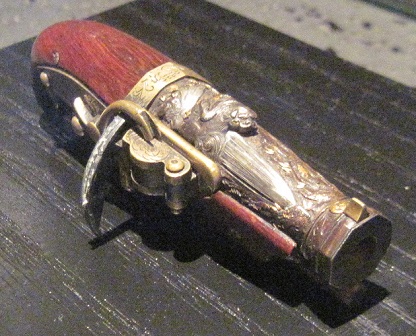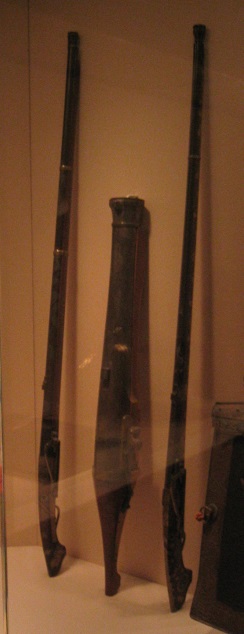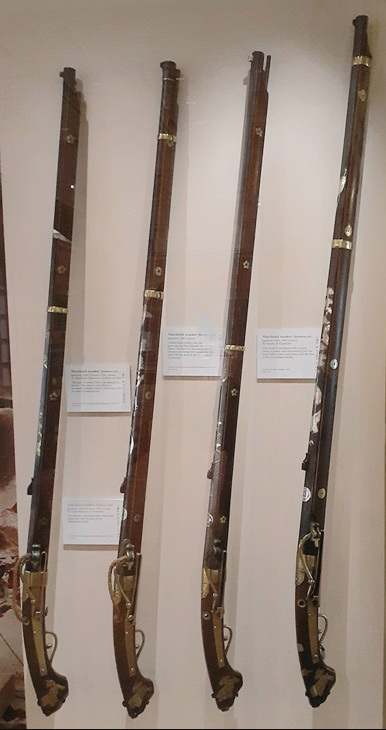Subject: 侍 samurai warrior
Culture: Japanese
Setting: Tokugawa shogunate, Japan 17th-mid 19thc
Object: 種子島 tanegashima matchlock guns = 鉄砲 teppō, hinawa-ju musket, 筒 zutsu pistol
Metropolitan Museum of Art > Stone Gallery of Arms and Armor*
"Matchlock Gun Iron, inlaid with silver; wood; silver; brass
Inscribed by Kunitomō Katsumasa Edo period, 18th century" ...
"Hand Cannon Iron, inlaid with gold and silver; wood; brass
Inscribed by Kazuki Nobumichi Edo, late 18th-early 19th century
The decoration on the barrel shows a carp ascending a waterfall, symbolic of success in life." ...
* Harwood International > Samurai Collection
"Bajozutsu (matchlock pistol) Edo period, 1603-1868 Wood, iron, gold ...
Blown off course in a strong storm, Portuguese sailors on a trade ship wrecked off the southern coast of Japan in 1543.
They brought the first firearms into the country [CONTRA Lorge 2008 p62] and samurai artisans skillfully replicated them.
This type, a bajozutsu (meaning 'horseback barrel'), was made to be used by mounted warriors."
Metropolitan Museum of Art > Stone Gallery of Arms and Armor *
Inscribed by Enamiya Sakubei Edo period, 18th century" ...
* Harwood International > Samurai Collection
"Tanzutsu (short-barreled pistol) Edo period, 1603-1868 Wood, iron, copper ...
To fire this miniature gun, a lit fuse was released into the flash pan, igniting the gun powder.
All matchlock guns were called teppō and the same firing mechanism was incorporated into rifle-sized firearms.
The barrel is adorned with a miniature shishi lion perching on a cliff overlooking a silver waterfall."
* Virginia War Museum > Fowler Gallery of Small Arms
"MATCHLOCK CARBINE, JAPAN, c.1850-1860 Also called the snaplock, the matchlock was the earliest form of mechanical ignition for firearms in Europe at the beginning of the 15th century. Early European explorers introduced the matchlock to the Far East where its use continued well into the 19th century, long after Europeans had adopted newer, more efficient systems." ...
*
Denix #804821 *
* Denix #804820
Higgins Armory Museum > Scimitars to Samurai: Arms around the World *
"Signed 'Norinao'; inlay by Matsudaira Hoki no Kami
Matchlock musket (teppo) decorated with family crests and dragons flying amidst clouds, about 1835-40
Japan Iron, silver, brass, gilding, wood and lacquer Weight: 9 lb. 7 oz. ...
When Europeans began to appear in Japan in the 1540s, they brought new technologies, including firearms.
By the 1550s, Japan's skilled craftsmen were producing their own versions of these weapons.
Tokugawa Ieyasu made expert use of musketeers in his wars to become shogun,
and he knew all too well how dangerous they could be to the established powers.
After he became shogun in 1603, firearm production was restricted, and existing examples were often transferred to government armories.
Japan was forced to reopen its doors."
* Royal Armouries Museum > Oriental Gallery
"Matchlock musket (hinawa-ju) Japanese, Omi Province, 19th century By Tonai Akiyoshi of Kunitomo
The barrel is decorated with cranes and pines, and with the mon of the Matsudaira family." ...
"Matchlock musket (hinawa-ju) Japanese, Omi Province, 19th century By Kunitomo Takeemon Norikiyo of Omi
This gun is named Yama (an allusion to death). The barrel is inscribed niju makiwari (double-folded), referring to the method of manufacture." ...
"Matchlock musket (hinawa-ju) Japanese, 19th century Called kichi (lucky); the names of these guns are on silver plaques under the butts.
The barrel is decorated with a phoenix hovering over a paulonia tree, and with the mon of the So, Lords of Tsushima." ...
"Matchlock musket (hinawa-ju) Japanese, Omi, 19th century By Yosuke of Kunitomo The stock is decorated with a shishi (lion),
a peony and a chrysanthemum, the barrel with cranes and pines, and the mon of the Matsudaira family." ...





